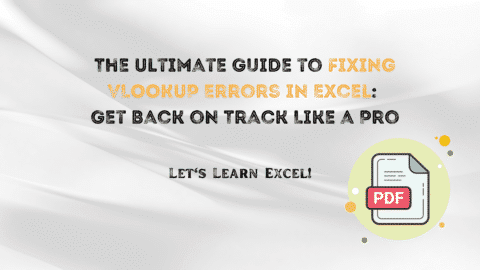Evaluate Formula in Excel: A Comprehensive Guide
Are you struggling to evaluate formulas in Excel? Do you find it difficult to debug formulas or check the accuracy of your calculations? Evaluating formulas is an essential skill for anyone who works with Excel, and it can help you save time and avoid errors. In this article, we will guide you through the process of evaluating formulas in Excel, step by step.
Table of Contents
Introduction
Excel is one of the most widely used spreadsheet programs in the world. It is a powerful tool for organizing, analyzing, and presenting data. One of the key features of Excel is its ability to perform calculations using formulas. Formulas can be simple or complex, and they can reference other cells, sheets, or workbooks. However, when working with complex formulas, it can be difficult to determine if the formula is correct or not. In such cases, the Evaluate Formula feature in Excel comes in handy.
How to Evaluate Formula in Excel
Here is a step-by-step guide on how to evaluate formula in Excel:
- Select the cell that contains the formula you want to evaluate.
- Click on the Formulas tab in the Ribbon.
- In the Formula Auditing group, click on Evaluate Formula.
- The Evaluate Formula dialog box will appear.
- Click on the Evaluate button to start evaluating the formula.
- Each part of the formula will be evaluated, and the results will be displayed in the dialog box.
- Click on the Step In button to evaluate the next part of the formula.
- Repeat steps 6 and 7 until the entire formula has been evaluated.
- Click on the Close button to close the Evaluate Formula dialog box.
Tips for Evaluating Formulas in Excel
Here are some tips to help you formulas in Excel more effectively:
- Use parentheses to group parts of the formula that need to be evaluated first.
- Make sure you understand the order of operations in Excel (PEMDAS: Parentheses, Exponents, Multiplication and Division, and Addition and Subtraction).
- Use the “Watch Window” feature to monitor the value of a cell as you evaluate the formula.
- Use the “Trace Precedents” and “Trace Dependents” features to see which cells are used in a formula and which cells depend on the formula.
- Use the “Evaluate Formula” feature in combination with these other features to get a better understanding of how a formula works.
Understanding the Evaluate Formula Dialog Box
The Evaluate Formula dialog box is a powerful tool that can help you debug formulas and check the accuracy of your calculations. Here are some key features of the Evaluate Formula dialog box:
- The Current Item box displays the part of the formula that is currently being evaluated.
- The Evaluate box displays the value of the current item.
- The Watch window allows you to monitor the value of specific cells or ranges as you evaluate the formula.
- The Evaluate button evaluates the current item.
- The Step In button allows you to step into a function or reference to evaluate it further.
- The Step Out button allows you to return to the previous level of the formula.
- The Close button closes the Evaluate Formula dialog box.
Common Errors When Evaluating Formulas in Excel
Evaluating formulas in Excel can be tricky, and there are a few common errors to watch out for:
- Forgetting to use parentheses to group parts of the formula.
- Misunderstanding the order of operations in Excel.
- Not using absolute references ($A$1) when referencing cells that should not change when copied to other cells.
- Forgetting to close parentheses in the formula.
- Using the wrong function or formula for the task at hand.
- Not understanding the purpose of certain functions or formulas.
FAQs
- What is the Evaluate Formula feature in Excel? The Evaluate Formula feature in Excel allows you to debug formulas and check the accuracy of your calculations.
- How do I evaluate a formula in Excel? To evaluate a formula in Excel, select the cell containing the formula, click on the Formulas tab, and then click Formula in the Formula Auditing group.
- Can I evaluate part of a formula in Excel? Yes, you can evaluate part of a formula in Excel by using the Step In button in the Evaluate Formula dialog box.
- How can I use the Formula feature to debug a formula? The Evaluate Formula feature allows you to step through a formula and see the value of each part of the formula. This can help you identify errors and debug the formula.
- Can I use the Evaluate Formula feature to check the accuracy of my calculations? Yes, you can use the Evaluate Formula feature to check the accuracy of your calculations by comparing the values in the Evaluate box to the expected values.
- Is the Formula feature available in all versions of Excel? Yes, the Formula feature is available in all versions of Excel.
Conclusion
Evaluating formulas in Excel can save you time and help you avoid errors. By using the Evaluate Formula feature, you can step through a formula and see the value of each part, making it easier to identify errors and debug the formula. We hope this guide has helped you understand how to evaluate formulas in Excel and how to use the Formula feature to your advantage.
Remember, practice makes perfect! The more you use Excel and the Evaluate Formula feature, the more comfortable you will become with it. Don’t be afraid to experiment with complex formulas, and use the Evaluate Formula feature to check your calculations.
In conclusion, the Formula feature in Excel is a powerful tool that can help you debug formulas and check the accuracy of your calculations. Following the step-by-step guide in this article, you can learn how to use the Formula feature and become a more efficient Excel user.
So, go ahead and give it a try! Evaluate your formulas in Excel and see how much time and effort you can save. We guarantee it will be worth it.
Hello, I’m Cansu, a professional dedicated to creating Excel tutorials, specifically catering to the needs of B2B professionals. With a passion for data analysis and a deep understanding of Microsoft Excel, I have built a reputation for providing comprehensive and user-friendly tutorials that empower businesses to harness the full potential of this powerful software.
I have always been fascinated by the intricate world of numbers and the ability of Excel to transform raw data into meaningful insights. Throughout my career, I have honed my data manipulation, visualization, and automation skills, enabling me to streamline complex processes and drive efficiency in various industries.
As a B2B specialist, I recognize the unique challenges that professionals face when managing and analyzing large volumes of data. With this understanding, I create tutorials tailored to businesses’ specific needs, offering practical solutions to enhance productivity, improve decision-making, and optimize workflows.
My tutorials cover various topics, including advanced formulas and functions, data modeling, pivot tables, macros, and data visualization techniques. I strive to explain complex concepts in a clear and accessible manner, ensuring that even those with limited Excel experience can grasp the concepts and apply them effectively in their work.
In addition to my tutorial work, I actively engage with the Excel community through workshops, webinars, and online forums. I believe in the power of knowledge sharing and collaborative learning, and I am committed to helping professionals unlock their full potential by mastering Excel.
With a strong track record of success and a growing community of satisfied learners, I continue to expand my repertoire of Excel tutorials, keeping up with the latest advancements and features in the software. I aim to empower businesses with the skills and tools they need to thrive in today’s data-driven world.
Suppose you are a B2B professional looking to enhance your Excel skills or a business seeking to improve data management practices. In that case, I invite you to join me on this journey of exploration and mastery. Let’s unlock the true potential of Excel together!
https://www.linkedin.com/in/cansuaydinim/










